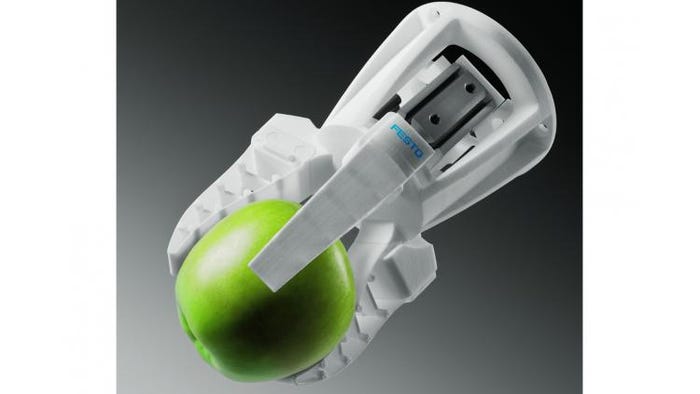Food safety considerations for automated packaging equipment
March 26, 2018

Food packaging safety contributor Gary Kestenbaum offers opinions on effective food safety practices when clients and equipment suppliers specify, design and integrate computer-assisted, robotic and other reduced resources/high-capability technology into food packaging processes.
The question arose recently as to whether migration to automation, robotics and artificial intelligence within product-sensitive industries (food, pharma) production processes increases or mitigates (product) risks to the health and welfare of consumers.
Like most everything else, the answer likely is both.
Many excellent technical articles describing food industry equipment construction and design standards are available online, so I won’t revisit that aspect of the subject. Rather, I’d prefer to address basic processes intended to address food and packaging safety through the application of comprehensive risk assessments.
Before we proceed, I’d like readers to know that I will be speaking on this subject of food safety in automated operations in a presentation during EastPack 2018 (June 12-14; New York City) on Thursday June 14 from 10:30-11:00.

A good analogy to the opportunities created by automation and robotics in food, beverage and pharma production might be the driverless vehicle. Supporters of the technology claim benefits that include consistency of operation and the elimination of operator variation. The robotic vehicle and control systems therein are not influenced by skills learned in driver education, compromised reaction times based on individual driver factors, driver fears, distractions, impairments and bad judgement. Therefore, stakeholders claim the ability to deliver a safe on-road experience in a driverless vehicle is positively influenced by consistency and uniformity and not negatively influenced by human over-reactive or unnecessary braking, improper observations, careless driving, distractions, substance abuse and so forth.
That rosy perspective is all fine and good until an unexpected catastrophe occurs, such as the shocking death of a pedestrian in Tempe, AZ, on March 18th who was struck and killed by a self-driving SUV outfitted with sensor systems, operating in autonomous mode. Making the event even more heinous was the alleged presence of a human backup driver in the vehicle.
In advance of that horrific event, I had planned to cite malfunctions, hacking, damage, equipment failure and false error notifications (from onboard self-diagnostic systems) as potential areas of risk within autonomous vehicles. Ironically, I also planned to mention the unquestioned value of redundancies and backup systems in place similar to pilots/autopilots in commercial aircraft, as though said redundancies would prevent the exact type of tragedy that occurred. That all changed following the unthinkable event in Tempe.
Partial automation with limited human oversight
Automation doesn’t remove human elements, it just changes the dynamics. Humans will still develop the project plan to automate based on economics, efficiency and productivity. Principles of risk and safety are still in effect: when specifying systems for food or pharmaceuticals, the project plan must include risk assessments, design safety, checks, balances and statistically defensible validation protocols. Whether engineers are designing manually operated or automated devices, each part, assembly, disassembly, adjustments, systems monitoring, sanitation and so forth needs to be considered, evaluated and included in a comprehensive written project assessment and execution manual.
The challenges regarding safety are then in the design, the operation, monitoring and validations (FAT) as well as a 50-shift commissioning defect-control timeframe.
Evidence strongly suggests that there are gaps in automated, self-driving car safety design and operation protocols which must be corrected to complement the application. The deadly accident in Tempe suggests that even the most sophisticated autonomous systems are exposed to design and operational errors and omissions which can lead to human harm. I’m hoping that this puts manufacturers and end users of automated, computerized and reduced-human-resource food and pharma packaging equipment systems on notice to reinforce risk and hazard analyses to consider weaknesses that might previously have been dismissed or underestimated.
Consider application risks and hazard potentials
When implementing and qualifying a robotic palletizer project, the expectation is low that the safety of edible product will be compromised. However, projects that involve the design and implementation of systems wherein picking, dosing, filling, sealing, etc. involves a comestible and its contact packaging, oversight and criteria must be based on an assumption that various hazards will compromise consumer health and welfare if not anticipated, identified, discussed, documented, mitigated or eliminated.
I recommend that equipment project managers take a Hazard Analysis Critical Control Points (HACCP) or Hazard Analysis and Risk-Based Preventative Controls (HARPC) team approach to food and pharma equipment automation and robotics project development. If a facility embarks upon a new, automated capital project with equipment to stage, store, convey, mix, dose, package and case-pack/palletize allergens or micro-sensitive components, the HACCP and HARPC risk analysis and food safety teams need to begin by fully documenting and mapping the process, end to end.
Manufacturing and installation engineers must, in turn, provide the safety team members with written evidence showing that each individual documented risk or hazard had been documented, explained, considered and mitigated (on paper) in principle. The design group would need to reconnect with the project engineers and explain how the designs met or exceeded sanitary design expectations. They’d need to explain how they concluded that the materials and design were “safe” and sanitary, within the contexts of the applications. If equipment designs or operation components are truly new (e.g., the self-driving car), is it reasonable to expect equipment supplier engineers to satisfactorily opine on the full gamut of risks and hazards?
Based on my experience, engineering companies are not necessarily trained or resourced to address all client food safety hazard and risk-related questions. Hazards and risks to comestible product safety depend upon many factors, and equipment fabricators may or may not have deep experience with your specific application.
Considering practicality and cost limits, very few clients are going to fund pilot test equipment that gets tested, torn down, redesigned, rebuilt, etc. multiple times before the final production version is commissioned. The experts charged with delivering safety are going to have to cobble together a process that takes some risks and judges some aspects of safety “on the fly” during limited and initial commercialization.
HACCP and HARPC teams are continuously challenged to answer both general and specific questions during the risk assessment process. Whether the equipment and processes are labor intensive or fully automated, the investigative and challenge questioning processes remain fundamentally similar. The technical Hazard Analysis team of cross-functional experts are the in-house stakeholders and caretakers for product safety, as they ponder how normal setup and operation of a process, including equipment, might be expected to cause or facilitate chemical, physical or microbiological contamination which would cause harm to human and animal users.
The general principles of an equipment and systems risk assessment and analysis remain consistent, but consider that participant competencies and expectations will adjust commensurate with project complexities. Not surprisingly, when equipment end-users or sponsors increase the complexity or risk profile of products, ingredients, changeovers, components, testing and so forth, the risk assessment oversight team has to adjust and address same, and is expected to do so with qualifications, knowledge, expertise and forethought. Creation of the process summary reference manual upon which the project manager will depend will reflect the same general objective: that is, the safe, effective and timely processing, packaging and palletizing of food or pharma grade product on sanitary equipment designed for the intended uses.
Next: Considerations for new lines, examples of department responsibilities

Considerations for new production lines
However, new operations with risk potential clearly in need of consideration include component sophistication, footprints, changeover complexity, reduced human oversight and so forth.
That’s what makes the risk and hazard analysis process so critical. If the project manager isn’t given a comprehensive summary of risks, design, oversight and maintenance criteria, the details are left to the judgement of those outside the client organization. Issues of materials composition and appropriate design standards will assumedly be considered and integrated by supplier experts, but the client risk assessment team members must do their homework and anticipate “what else or new can go wrong” in addition to the previously identified and considered calamities documented in existing prior risk potential summaries created by “the team.”
Typically, the food equipment client project manager responsible for executing the project is not an expert in technical disciplines of microbiology, sanitation, food safety and related. Rather, the project manager is tasked with coordination of efforts and delivering an on-time, in-budget completion. In my experience, each cross functional hazard analysis team member should prepare, promote and champion a discipline-specific food safety agenda and once the information and recommendations are disseminated to client management, the “baton is passed.” Recognize that in a marketing-based organization, management makes final decisions and if an aspect of equipment design results in a food safety failure, make sure that your recommendations were communicated so that you or your function does not “own that failure.”
Responsibility examples
Examples of functional hazard team responsibilities include:
The quality function representative should oversee the hazard and risk assessment teams’ creation of an accurate summary of process activities within which the equipment will function. Focus should be on sensitive ingredients, components, changeovers, sanitation and expected degrees of difficulty.
Maintenance should create a section describing how change parts, inspection, adjustment and other hands-on, maintenance-related activities are expected to occur within the normal work environment.
Technical research should speak to incoming, intermediate and finished product-in-package expectations, limits, variations, risks and in-specification quality.
Operations staff and management representatives should collaborate to document production oversight, human resources and criteria for safe and effective operation. It must be noted that new automation systems represent many unknowns. Therefore, training, oversight and communication must be coordinated within the operations function.
Engineering should explain and document how “new” equipment, components, controls, processes and footprints integrate and synchronize with existing infrastructure, in addition to their typical guidance for regulatory and client-specified design criteria (small parts, delamination, forbidden materials, NEMA ratings, clean-out-of-place (COP)/clean-in-place (CIP) designs, etc). Engineering might also own ideation for redundancies to improve safety and reduce risk (recall the self-driving car human operator example).
Food Safety team members should ensure that there is a draft HACCP/HARPC plan created to identify and mitigate physical, chemical and microbiological risks and hazards associated with the new process. They should also collaborate with maintenance counterparts to identify how best to inspect and approve safe production restarts following downtime for any and all maintenance-related activities.
Sanitation managers need to study documents and manuals supplied by the equipment vendors in order to understand and then challenge how the state-of-the-art equipment can and will be cleaned, sanitized and maintained to create consistent and safe consumables.
Accompanying maintenance, testing, changeover, sanitation, and adjustment manuals need to be written in plain-speak, including technical language and local jargon alike, so that every maintenance and engineering resource can understand expected, unified processes.
In summary, I recommend that the client engineers and project managers approach new and/or complex food equipment design and installation projects based on objectives, requirements and component knowledge designed to deliver safe products.
Every unfamiliar component of a process requires new learning, expert advice and tutorials, a thorough review and the expectations of previously unfamiliar errors, omissions and learning curves. Automation, sophisticated controls, artificial intelligence and other state-of-the-art components will naturally add complexity and challenges to the food safety risk and hazard identification and mitigation process, but, procedurally, the process objectives remain consistent.
Many eyes watch cutting-edge equipment projects initially and a safe, steady-state condition is often not easy to achieve. However, at some point the system is expected to pay for itself by operating “at advertised speed” with reduced human oversight. Thus, all criteria for success used to rate product and process safety during factory acceptance tests and related statistical commercialization assessments need to be comprehensive, well documented and understood by all. Compare the process statistically to odds at the casino. Run the system for enough hours and the product quality results will match the true odds for an error. Hazards and risks do exist and product failures will occur. Long-term success will be proportionate to design efficiency, client oversight and the continuous application of expected suitable resources. High-end equipment will properly perform and sustain safe output of goods when it in kind has been adequately designed and is continuously reviewed, adjusted, supported and maintained through skilled oversight and focused documentation.
You can hear Gary Kestenbaum in person address the topic of food safety considerations in an automated production operation during EastPack 2018 (June 12-14; New York City) on Thursday June 14 10:30-11:00.
Gary Kestenbaum is an independent food packaging safety consultant with 45 years of experience in the food industry as a food ingredient technician with National Starch, a food product developer with General and Kraft Foods, a package developer with Kraft Foods and as a food packaging safety consultant with EHA Consulting Group. He can be contacted at [email protected].
About the Author(s)
You May Also Like




